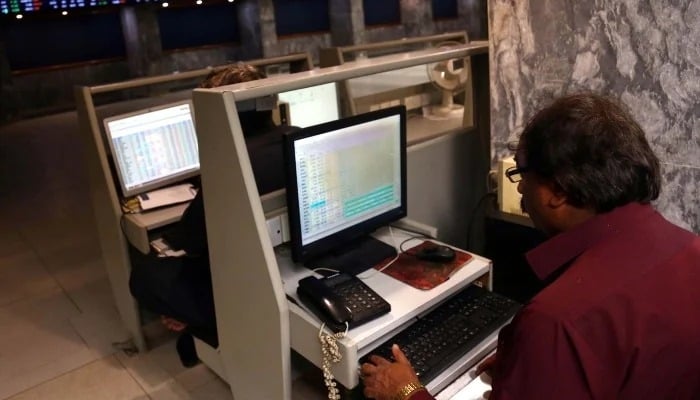Buoyed by budget clarity, falling interest rates, and sustained investor optimism, Pakistan’s equity market surged further on Tuesday, with the KSE-100 Index trading at an all-time high level.
“Aggressive buying by local investors has pushed the KSE-100 Index past the 128,000 mark, gaining over 2% from yesterday’s close,” said Mohammad Sohail, CEO of Topline Securities.
“The rally comes on the back of budget clarity and declining interest rates, prompting increased equity exposure from domestic investors,” he added.
The Pakistan Stock Exchange’s (PSX) benchmark KSE-100 Index jumped 2,572.11 points, or 2.05%, to settle at 128,199.42, closing above the 128,000 mark for the first time ever.
It touched an intraday high of 128,475.69, gaining as much as 2,848.38 points, or 2.27%, while the day’s low remained at 126,113.27.
Prime Minister Shehbaz Sharif welcomed the record-setting performance of the stock market, thanking the business community and investors for supporting the government’s economic vision, in a statement issued on APP.
“The new fiscal year has begun with good news and a significant development in the economic field, which is very propitious,” he said.
He said that the KSE-100 Index reaching its highest level is a manifestation of the fact that the confidence of the business community and investors in the country’s economy and government policies was strengthening and stabilising with each passing day.
He attributed the market’s rise to the consistent, gradual recovery achieved during the last fiscal year and expressed confidence that FY26 would prove to be a milestone for Pakistan’s economic trajectory.
“The new fiscal year will prove to be a milestone in the journey towards improving the country’s economy. The government is making efforts to promote the best business environment and provide more facilities to investors. I pay tribute to the government’s economic team for this success,” he added.
The capital market continued its record-breaking momentum on Tuesday as investor confidence remained elevated following the close of a stellar fiscal year marked by macroeconomic gains and strong foreign support.
The Pakistan Stock Exchange’s (PSX) benchmark KSE-100 Index climbed to record-breaking intraday high of 127,538.99, gaining 1,911.68 points, or 1.52%, while the session’s low stood at 126,113.27, up 485.96 points, or 0.39%, from the previous close of 125,627.31.
“The PSX’s ongoing rally is a long-overdue recognition of corporate profit growth that’s been building since 2017, previously overshadowed by macroeconomic concerns,” said Amreen Soorani, Head of Research at Al Meezan Investment.
She further noted: “Even after a 3x gain in two years, the PSX’s P/E sits at a mere 6.3x. This is still low compared to its historical average of 7-8x, and significantly below the 10x+ seen in more prosperous times. As companies continue to deliver strong profits and dividends, a return to these historical valuation norms takes the index to around 150,000, signalling ample room for further valuation upside as ongoing macro reforms solidify.”
Stocks ended the fiscal year 2025 with a remarkable 60% year-on-year gain, as the benchmark index settled at a historic high on Monday following a 1,248-point surge, driven by renewed investor confidence after China refinanced and rolled over $3.4 billion in commercial loans to Pakistan.
According to Topline Research, the KSE-100 Index has risen 60% in PKR terms and 57% in USD terms over FY25, making it the eighth best-performing stock market globally. Over the past two years (FY24–25), the index has posted a cumulative gain of 203% in PKR and 206% in USD, underpinned by macroeconomic stability secured through the IMF programme.
Other catalysts for the bull run included the completion of Pakistan’s first IMF review in March 2025, aggressive monetary easing from 20.5% to 11%, Fitch’s upgrade of Pakistan’s credit rating from CCC+ to B-, improving macroeconomic indicators, and rising market liquidity as investors shifted capital from fixed income to equities.



